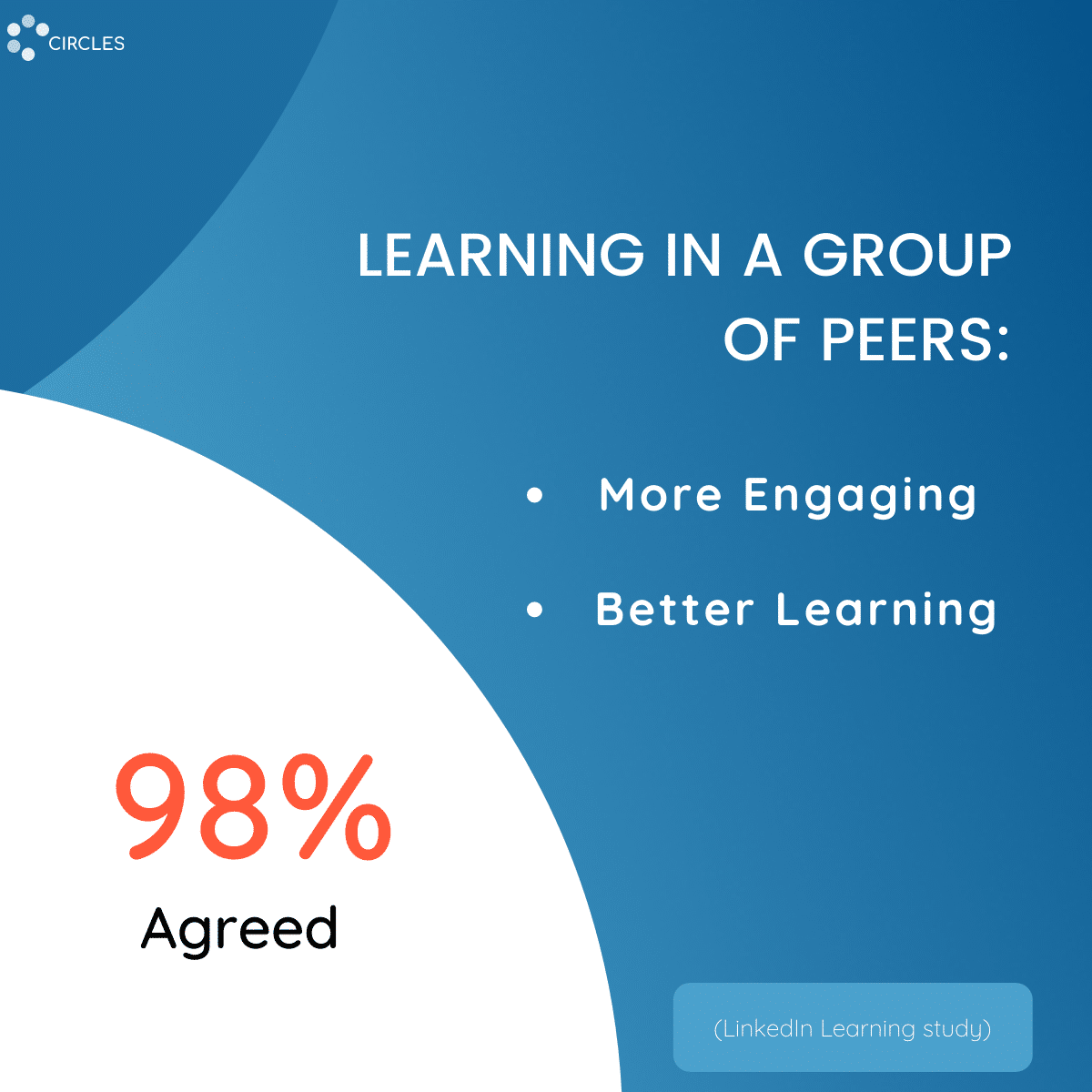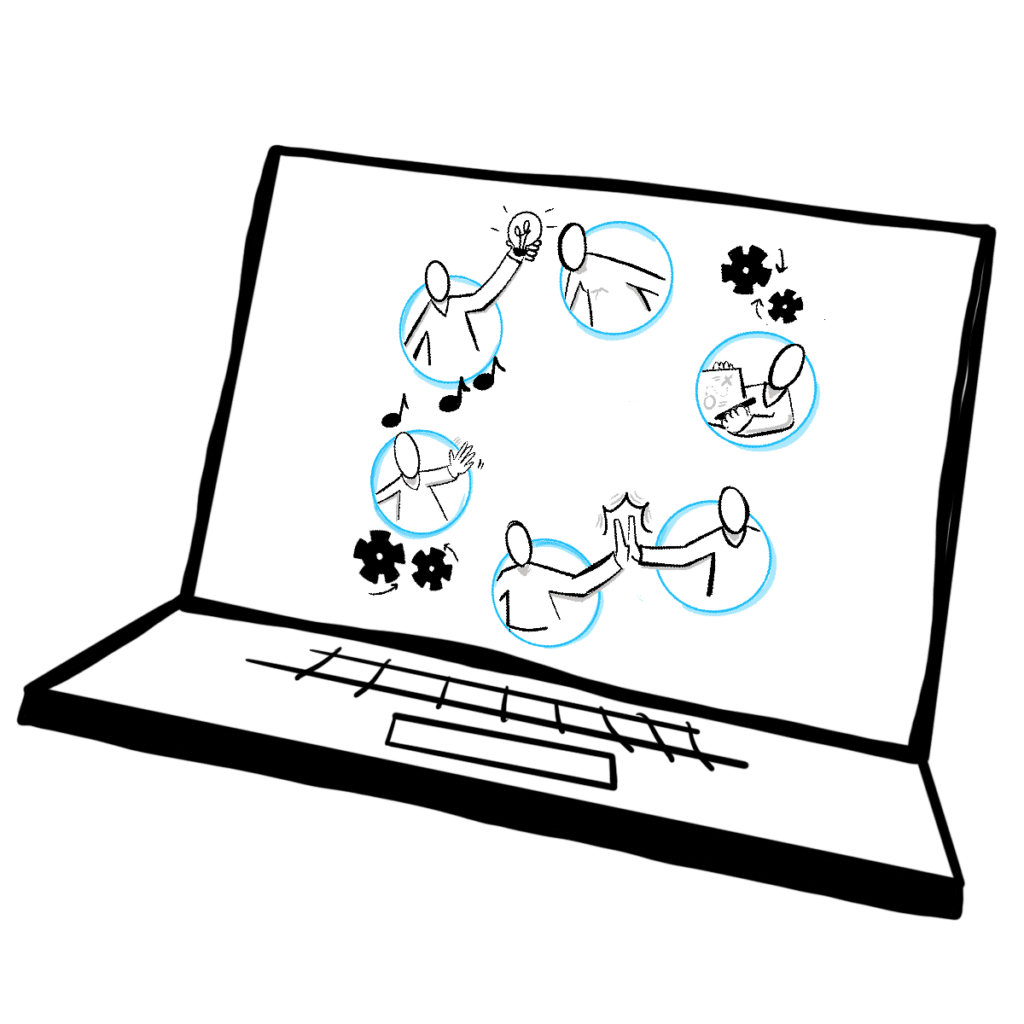Over the years, our team at Circl.es has worked to define the magic Circl.es offers and locate ourselves in a particular category. Those of us who have experienced a successful YPO forum, Aspen Fellowship, or Mastermind will understand what I’m talking about: the unparalleled deep human connection and growth experienced in those spaces is hard to describe, let alone categorize. At the intersection of three massive markets – “Education,” “Collaboration,” and “Community” we’ve found a specific category: “Social Learning.” In this post, we’ll share a few thoughts about the benefits and limitations of categorizing circles as “social learning.”
Social Learning in Action
The label “social learning” encompasses two intertwined outcomes that circles accomplish: (1) enhancing learning and development programs and (2) building the deep ties that create community. Many existing programs today defy categorization as one or the other, especially, diversity, equity and inclusion programs. Sometimes a use-case emphasizes “social,” sometimes “learning,” but both are always present.
On the social side, Glassdoor recently used social learning structures to help employees connect to process the war in Europe. Many leaders fear that divisive issues of our time will rip the social fabric of their organizations, but Glassdoor saw the crisis as an opportunity to care for employees. The facilitated circles gathered people from around the world, and proved to be especially meaningful for employees with personal ties to Ukraine and Russia. There was an agenda, but the focus was more social: with a unique opportunity to socialize on a global scale, employees shared their feelings and brainstormed possible ways to help each other.
On the learning side, a global supermarket conglomerate layered circles into a learning journey for rising high-potential leaders. Their program success criteria included practice and application of specific competencies: in the first year of the program, the circles emphasized social aspects of the experience like networking and connection, and value scores came back good, not great. For the program’s second year, we tuned the experience–making it more application focused–and Circles became the highest rated component of the journey.
Defining Social Learning
Social learning theory stems from behavioral psychology, and rests on the idea that humans naturally observe, encode and then imitate others around them. We learn how to be human through our social environments. We aren’t necessarily aware of social learning taking place–it’s simply happening to us all the time. Asocial learning, by contrast, refers to individuals learning on their own, through trial and error. Social learning begins at home when we’re children, continues through our developmental years in school, and extends throughout our lives into the workplace. One of our favorite books about social learning is not academic at all: “The Inner Game of Tennis” unpacks just how much we learn from observing and imitating, vs being told what to do.
One common question is, “but don’t I need an expert?” If we allow learning to happen peer-to-peer, won’t people simply copy each others’ rookie mistakes? The answer is a bit counterintuitive. Vygotsky–a prominent contributor to social learning theory–explained “proximity theory:” We actually learn more from people close to our level, and are more likely to notice their mistakes as our own and correct them, while an expert’s’ teaching goes over our heads. As a teenager, I went to a military academy for a summer of Russian-language immersion; we were strictly forbidden to speak English, and I was a beginner. I felt like I was living with other neanderthals, our communication skills reduced to the Russian equivalent of “Me want food.” But in the end, my language skills progressed at an almost magic pace, with all kinds of silly fun along the way.
A few sticking points with using the phrase social learning: first, it’s sometimes used with “social media,” which certainly has some social learning applications. Social learning isn’t using your friends to engage you with one-way entertainment–there has to be conversation and community involved. Second, Social learning is sometimes lumped in with ‘peer learning,’ which is more a subset of what we do. And third, for many people “learning” is a complicated word. It harkens back to school and rows-based learning experiences, where the expectation is mastering facts. Social learning is much more about exploring uncertainty together than transmitting certain facts. So, even as we adopt the category “social learning,” we’ve got work to do to establish its definition.
Social Learning Benefits
Studies have established the workplace benefits of social learning. For instance: in a recent LinkedIn Learning remote work study, one of the top ten L&D strategies identified that driving hybrid workplace engagement involves making learning more social. The study revealed that 98% of participants agreed that people generally learn better together, and are much more engaged when learning in a group of peers. One practical suggestion from the study: ‘don’t simply convert in-person training into video conference. Reimagine how live virtual could look: Can you drop the slides and just have a conversation?” (LinkedIn Learning study).
Psychologists agree: trading slide decks for dialogue fundamentally changes the way we work together. Because people mimic one another and naturally integrate each others’ emotional expressions to better connect, two brains function better than one. Conversations facilitate more than sharing information; remarkably, by boosting the production of hormones and neurotransmitters, dialogue causes physical and emotional changes in the brain. The result is transformational conversations and social learning.
The sheer number of professionals seeking out peer learning communities for themselves is another data point proving the power of social learning. Consider the recent rise of Chief to Unicorn status. Describing themselves as “the only private membership network focused on connecting and supporting women executive leaders,” their brand promise is not simply to network and climb corporate ladders together, but to connect and grow: “Connect to a network of leading women, build a personal board of advisors, unlock access to prominent business experts and programming, and grow as a leader.”
Applying Workplace Social Learning
Many workplace learning and development professionals subscribe to something like the 70-20-10 rule, which acknowledges that formal learning comprises merely 10% of a professional’s learning journey (20% comes from developmental relationships like mentors, and the other 70% happens on-the-job). Yet despite what these numbers show, most budgets are still invested in formal learning–webinars, multiple-choice assessments, and other one-way communication experiences. Luckily, In these formal settings, social learning can’t help but take place in the margins–during the breakout groups and side conversations, if those are provided. But many L&D professionals are left struggling to impact the crucial development going on during 90% of a professional’s learning.
A way through this conundrum is to establish social learning practices in the formal experience, and then extend them into the remaining 90% of the calendar. When bosses carve out time and space for reflection during work, strong social ties carry over. Intentionally layering social learning into formal settings matches people with intention, and these relationships reinforce learning objectives over time.
In short, we’ve found that all the benefits of social learning, can easily be added to stuff you’re already doing, provided there’s three elements: space, facilitation and re-defining success:
- Make space – leaders must set aside task lists and dedicate time to social learning
- Facilitate – minimal strategic structure and/or guidance
- Reset Expectations– shifting from having all the answers to welcoming questions, which takes vulnerability and listening with a growth mindset.
Organizations that have infused social learning throughout their programs, projects, and teams experience transformation. They start to approach what Peter Senge and others call a ‘learning organization’. Because they’ve built trust, they innovate faster together. They are more agile. And in the end, they are fun, safe places to work, filled with human connection, a sense of belonging and a comfort in your own skin.
What do you practitioners and participants think? Is Social Learning the right label for what you’re all raving about?





 The road ahead
The road ahead

